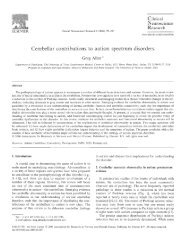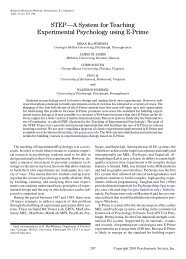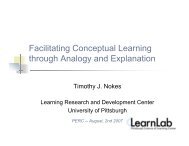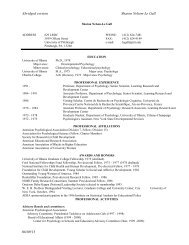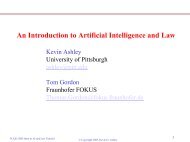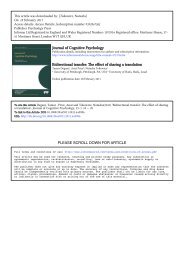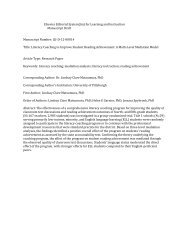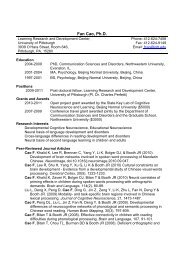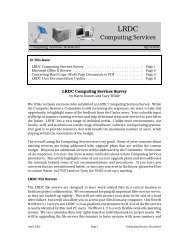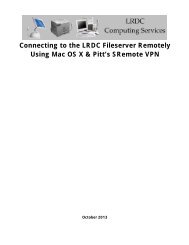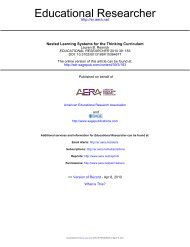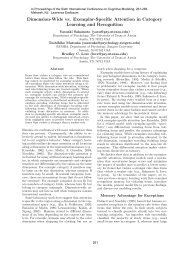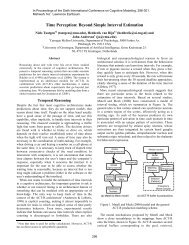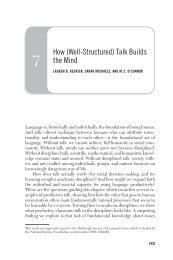[on] how people learn science - Learning Research and ...
[on] how people learn science - Learning Research and ...
[on] how people learn science - Learning Research and ...
You also want an ePaper? Increase the reach of your titles
YUMPU automatically turns print PDFs into web optimized ePapers that Google loves.
Science-rich instituti<strong>on</strong>s Provide Venues<br />
For children to enjoy explorati<strong>on</strong><br />
BY<br />
eriK W.<br />
rOBeleN<br />
Albuquerque, N.M.<br />
On a recent evening,<br />
hundreds<br />
of children <strong>and</strong><br />
their families<br />
climbed off<br />
school buses<br />
<strong>and</strong> filed into a<br />
<strong>science</strong> center<br />
in this city’s historic<br />
Old Town<br />
neighborhood. The event that drew<br />
them, dubbed Family Science Night,<br />
was no invitati<strong>on</strong> to hear a lecture<br />
<strong>on</strong> climate change or quantum<br />
physics, or to catch a documentary<br />
<strong>on</strong> a gigantic i m a x screen.<br />
Instead, families from two highpoverty<br />
public schools dived into an<br />
array of h<strong>and</strong>s-<strong>on</strong>, interactive exhibits<br />
separated into small alcoves<br />
in a place aptly named Explora,<br />
Spanish for “explore.”<br />
And explore they did. Children got<br />
their h<strong>and</strong>s wet—literally—as they<br />
manipulated objects in water-based<br />
displays in the Water of Life, Life of<br />
Water exhibit area. They tapped <strong>on</strong><br />
a keyboard in the Shapes of Sound<br />
secti<strong>on</strong> that produced not t<strong>on</strong>es but<br />
deep vibrati<strong>on</strong>s felt through the<br />
bench <strong>on</strong> which they sat. Over in<br />
the Moving Air secti<strong>on</strong>, they sliced<br />
up paper cups to see <strong>how</strong> different<br />
sizes <strong>and</strong> shapes would float<br />
or twirl when placed atop a barrel<br />
with a fan inside blowing air toward<br />
the ceiling.<br />
“Hey, Daddy, come <strong>and</strong> look at<br />
this!” a young boy blurted out as<br />
his paper creati<strong>on</strong> in the Cup Copter<br />
exhibit danced in the air.<br />
Amid c<strong>on</strong>cern that the United<br />
States is failing to adequately prepare<br />
young <strong>people</strong> with the knowledge<br />
of <strong>science</strong> <strong>and</strong> related fields<br />
they need to thrive as individuals<br />
<strong>and</strong> keep the nati<strong>on</strong> globally<br />
competitive, recogniti<strong>on</strong> is<br />
growing that the vast American<br />
l<strong>and</strong>scape of <strong>science</strong>-rich<br />
instituti<strong>on</strong>s can play a powerful<br />
role in addressing the situati<strong>on</strong>.<br />
Science centers <strong>and</strong> museums,<br />
botanical gardens, zoos, aquariums,<br />
<strong>and</strong> natural-history museums,<br />
am<strong>on</strong>g others, help the public gain<br />
a better underst<strong>and</strong>ing of <strong>science</strong>.<br />
They also excel at inspiring curiosity<br />
<strong>and</strong> a passi<strong>on</strong> for <strong>science</strong>-related<br />
topics in ways that experts say are<br />
all too rare in the classroom.<br />
Such organizati<strong>on</strong>s have a big<br />
audience. In 2008, a majority of<br />
Americans said they had visited an<br />
informal <strong>science</strong> instituti<strong>on</strong> such as<br />
a zoo or natural-history museum<br />
over the past year, according to a<br />
report from the Nati<strong>on</strong>al Science<br />
Board. About <strong>on</strong>e in four had visited<br />
a <strong>science</strong> center like Explora.<br />
Science centers <strong>and</strong> museums,<br />
in particular, have mushroomed in<br />
recent decades, both in the United<br />
States <strong>and</strong> abroad, notes Alan J.<br />
Friedman, a former director <strong>and</strong><br />
chief executive officer of the New<br />
York Hall of Science in New York<br />
City. Still uncomm<strong>on</strong> in the 1960s,<br />
they can be found today in virtually<br />
every major metropolitan area of the<br />
country—<strong>and</strong> plenty of smaller communities,<br />
too—from Liberty Science<br />
Center in Jersey City, N.J., to the<br />
Ann Arbor H<strong>and</strong>s-On Museum in<br />
Michigan, to <strong>on</strong>e of the pi<strong>on</strong>eers, the<br />
Exploratorium in San Francisco.<br />
The most explosive growth occurred<br />
during the 1970s <strong>and</strong> 1980s,<br />
according to Mr. Friedman, who said<br />
there are now more than 350 <strong>science</strong><br />
centers, museums, <strong>and</strong> related instituti<strong>on</strong>s<br />
across the nati<strong>on</strong>.<br />
“That’s just ast<strong>on</strong>ishing to<br />
build cultural instituti<strong>on</strong>s<br />
at that rate,” he said.<br />
Experts say most <strong>science</strong><br />
centers <strong>and</strong> museums, like<br />
schools, have a core missi<strong>on</strong> of<br />
educating the public, but plenty of<br />
big differences exist. Perhaps most<br />
obvious, they are “free choice” envir<strong>on</strong>ments:<br />
People can take them<br />
or leave them. And visitors decide<br />
where to linger <strong>and</strong> what to ignore.<br />
Also, most visitors come <strong>on</strong>ly <strong>on</strong><br />
rare occasi<strong>on</strong>s.<br />
The forte of these instituti<strong>on</strong>s is<br />
highly engaging, <strong>and</strong> usually h<strong>and</strong>s<strong>on</strong>,<br />
activities <strong>and</strong> exhibits that try<br />
to bring theoretical c<strong>on</strong>cepts to life<br />
with power <strong>and</strong> immediacy.<br />
‘iNSPiraTiONal<br />
DiScOVerY’<br />
Explora, with a stated missi<strong>on</strong> of<br />
“creating opportunities for inspirati<strong>on</strong>al<br />
discovery <strong>and</strong> the joy of life-<br />
l<strong>on</strong>g <strong>learn</strong>ing through interactive<br />
experiences in <strong>science</strong>, technology,<br />
<strong>and</strong> art,” was born in 1995 as a result<br />
of the merger of a small <strong>science</strong><br />
center <strong>and</strong> a children’s museum. Financial<br />
support comes from several<br />
sources, including earned income,<br />
public dollars from the city <strong>and</strong><br />
the state, <strong>and</strong> corporati<strong>on</strong> <strong>and</strong><br />
foundati<strong>on</strong> grants.<br />
With about 20,000 square feet<br />
of exhibit space, Explora is <strong>on</strong><br />
the small end am<strong>on</strong>g <strong>science</strong><br />
centers <strong>and</strong> museums, dwarfed<br />
by venues such as the California<br />
Science Center in Los Angeles<br />
<strong>and</strong> the Museum of Science <strong>and</strong><br />
Industry in Chicago, which, according<br />
to its website, is home to<br />
some “35,000 artifacts <strong>and</strong> nearly<br />
14 acres of h<strong>and</strong>s-<strong>on</strong> exhibits.”<br />
Indeed, while some of these instituti<strong>on</strong>s<br />
have significant collecti<strong>on</strong>s,<br />
<strong>and</strong> even house full-fledged<br />
natural-history museums, Explora<br />
does not.<br />
Its exhibits are essentially <strong>learn</strong>ing<br />
activities, said Paul Tatter, the<br />
associate director.<br />
“The place is organized into clusters<br />
of very small exhibits,” he said.<br />
“Most of the exhibits are things that<br />
you can hug. You can get your arms<br />
around them. They fit <strong>on</strong> tabletops.”<br />
Visitors are invited to investigate<br />
with their h<strong>and</strong>s, rather than spend<br />
a lot of time reading explanatory<br />
text. One kindergarten teacher<br />
visiting recently with her class<br />
gushed that her students “get<br />
to touch everything.”<br />
At the Cup Copter display,<br />
visitors experiment with <strong>how</strong><br />
changing variables about the<br />
paper cups, such as modifying the<br />
wing length <strong>and</strong> angle or changing<br />
the weight, alter <strong>how</strong> they<br />
float or spin.<br />
“Part of it is the process of investigati<strong>on</strong>,”<br />
said Betsy Adams<strong>on</strong>, Explora’s<br />
exhibits director. “Visitors get<br />
experience with scientific c<strong>on</strong>cepts<br />
even if they d<strong>on</strong>’t get the names.”<br />
Mr. Tatter, previously the center’s<br />
executive director, said Explora is<br />
not designed to teach specific c<strong>on</strong>tent:<br />
“We d<strong>on</strong>’t determine ahead of<br />
time what the experience is supposed<br />
to be.”<br />
Staff members say that great<br />
care is taken in providing materials<br />
that will foster meaningful<br />
explorati<strong>on</strong> <strong>and</strong> <strong>learn</strong>ing. In additi<strong>on</strong>,<br />
the members of the floor staff<br />
are seen as integral to facilitating<br />
the experience.<br />
S8 Educati<strong>on</strong> WEEK: sciEncE lEarning outsidE thE classroom l www.edweek.org/go/<strong>science</strong>report l april 6, 2011<br />
MUSeUM<br />
MeNU<br />
Explora offers a host of<br />
programs <strong>and</strong> initiatives<br />
to promote <strong>science</strong> <strong>learn</strong>ing<br />
<strong>and</strong> engagement.<br />
“The<br />
staff is<br />
part of the<br />
exhibit in a sense,”<br />
said Kristin W. Leigh, the<br />
director of educati<strong>on</strong>al services.<br />
The Albuquerque center has<br />
drawn nati<strong>on</strong>al notice for its work.<br />
Explora is <strong>on</strong> the “innovative<br />
edge” am<strong>on</strong>g <strong>science</strong> centers <strong>and</strong><br />
museums, said Mr. Friedman, who<br />
now c<strong>on</strong>sults with such facilities<br />
around the country. “One [example]<br />
is the physical arrangement <strong>on</strong> the<br />
floor to encourage families to stay<br />
l<strong>on</strong>ger <strong>and</strong> get deeper into each activity,”<br />
he said. “Another is the use<br />
of <strong>on</strong>-floor staff who pose questi<strong>on</strong>s<br />
more than answer them.”<br />
Like many <strong>science</strong> centers, Explora<br />
has developed a big menu of<br />
educati<strong>on</strong>al offerings <strong>and</strong> activities<br />
that go bey<strong>on</strong>d the exhibit floor. For<br />
example, it runs after-school clubs<br />
<strong>and</strong> summer camps <strong>and</strong> provides<br />
professi<strong>on</strong>al development for teachers.<br />
It’s established an extensive<br />
youth-intern program that provides<br />
support <strong>and</strong> training for high school<br />
students who help with various educati<strong>on</strong>al<br />
programs—<strong>and</strong>, in some<br />
cases, run them—<strong>and</strong> interact with<br />
visitors <strong>on</strong> the exhibit floor.<br />
Explora also offers a selecti<strong>on</strong><br />
of some 200 hourl<strong>on</strong>g, h<strong>and</strong>s-<strong>on</strong><br />
classes, called “explorati<strong>on</strong>s,” both<br />
<strong>on</strong> site <strong>and</strong> in public schools, community<br />
centers, <strong>and</strong> senior-living<br />
facilities, that are run by the center’s<br />
staff of full-time educators.<br />
The explorati<strong>on</strong>s are benchmarked<br />
to New Mexico’s state st<strong>and</strong>ards in<br />
<strong>science</strong>, math, or art.<br />
Experts say most <strong>science</strong> centers<br />
try to ensure a diverse audience—<br />
including minority <strong>and</strong> low-income<br />
families who ordinarily may be less<br />
growing a Scientist<br />
A biweekly program in which<br />
children ages 2-4, accompanied<br />
by an adult, explore basic <strong>science</strong><br />
principles together through<br />
playful experiences.<br />
Science to grow On<br />
Children from K-3 <strong>learn</strong> about<br />
<strong>science</strong> through questi<strong>on</strong>ing,<br />
experiencing, <strong>and</strong> investigating<br />
in this biweekly program.<br />
Helping H<strong>and</strong><br />
Free annual museum memberships<br />
for low-income families.<br />
Teacher Professi<strong>on</strong>al<br />
Development<br />
offers half-day workshops for educators<br />
<strong>on</strong> topics such as designing<br />
<strong>learn</strong>ing envir<strong>on</strong>ments, asking questi<strong>on</strong>s<br />
that support cognitive growth,<br />
<strong>and</strong> facilitating a <strong>science</strong> fair.<br />
classroom explorati<strong>on</strong>s<br />
offers more than 200 hourl<strong>on</strong>g,<br />
experiential programs, called “explorati<strong>on</strong>s,”<br />
for preschoolers through<br />
12th graders facilitated by Explora<br />
educators <strong>and</strong> benchmarked to<br />
state st<strong>and</strong>ards. Examples include<br />
<strong>how</strong> does your Garden Grow?,<br />
Light <strong>and</strong> shadow, <strong>and</strong> triangles<br />
<strong>and</strong> tribulati<strong>on</strong>s. Also offers some<br />
explorati<strong>on</strong>s for older adults.<br />
Youth intern Program<br />
At-risk high school students<br />
participate in a three-year internship<br />
in which they are trained<br />
to help with various educati<strong>on</strong>al<br />
programs —<strong>and</strong> in some cases<br />
run them—as well as interact<br />
with visitors <strong>on</strong> the center’s<br />
exhibit floor.<br />
after-School clubs<br />
Runs clubs both <strong>on</strong>site <strong>and</strong> in<br />
the community, including Robo<br />
task Force, focused <strong>on</strong> robotics;<br />
Art/tech, which explores<br />
<strong>science</strong>-art c<strong>on</strong>necti<strong>on</strong>s,<br />
especially using digital technology;<br />
<strong>and</strong> Niñas Explor<strong>and</strong>o la<br />
Ciencia (spanish for “girls doing<br />
<strong>science</strong>”).<br />
Portal to the Public<br />
Local scientists, working closely<br />
with Explora staff members, give<br />
a presentati<strong>on</strong> <strong>on</strong> the exhibit<br />
floor with materials-based activities<br />
to c<strong>on</strong>vey their research to<br />
the public.<br />
Spring Break<br />
<strong>and</strong> Summer camps<br />
offers half-day or full-day camps<br />
focused <strong>on</strong> activities that explore<br />
<strong>science</strong>, technology, <strong>and</strong> art.<br />
soURCE: Explora


![[on] how people learn science - Learning Research and ...](https://img.yumpu.com/4764286/10/500x640/on-how-people-learn-science-learning-research-and-.jpg)
